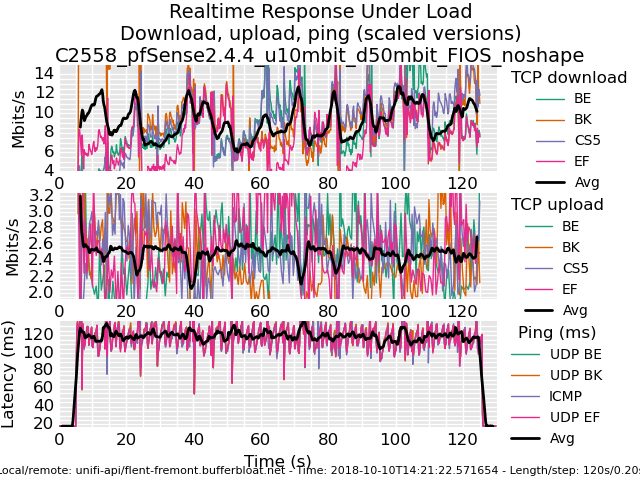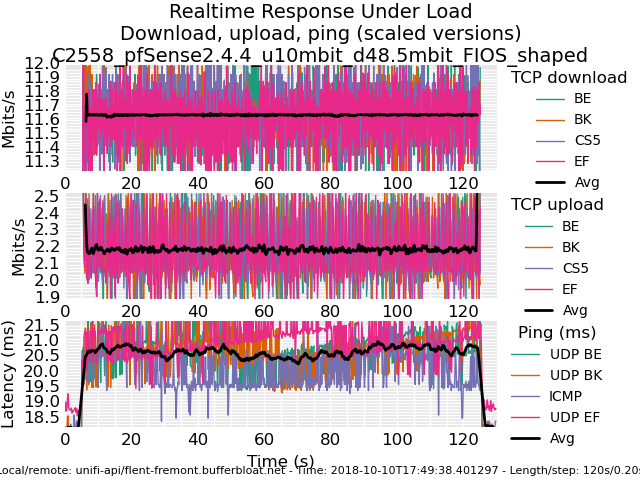Playing with fq_codel in 2.4
-
@tman222 said in Playing with fq_codel in 2.4:
Hi @zwck
It's a lot of trial and error (i.e. testing) to see what works best for your use case(s). Keep in mind that a lot of the guides you will find are for tuning host computers and some of those suggestions may not work well for a firewall appliance.
One other site that I have gotten some helpful tuning info from has been the BSD Router Project, for example:
https://bsdrp.net/documentation/technical_docs/performanceHope this helps.
I just quickly skimmed this section with the outcome:
changing :machdep.hyperthreading_allowed="0" -> 24% increased performance net.inet.ip.fastforwarding=1 (useless since freebsd11) hw.igb.rxd or hw.igb.txd -> decrease performance hw.igb.rx_process_limit=100 to -1 -> improvement, 1.7% max_interrupt_rate from 8000 to 32000 -> no benefit Disabling LRO and TSO -> no impact -
@zwck I don't get how that could be. Both tests use netperf, right? The two test outputs provided were from the same host. So odd.
-
@sciencetaco i probably don't understand you properly:
I think what you linked shows the same result - flent shows 150 down and about 10 up and your script output shows 150 down and 10 up
-
@zwck I think I overlooked the 4x multiplier on flent in your original reply,my bad. This satisfied my brain's need for clarification. thank you!!
-
At one level, I'm apologetic about the default rrul plot being so complicated. You get the most at a glance that way. You can certainly choose to output the totals plot instead, if that's what you want. My fear was that people would just look at that all the time instead of the more complicated one, and my other fear was that people wouldn't actually switch to using the gui to more fully analyze the data.
And my third fear was that people wouldn't use the other tests. You can test your
download or upload in isolation with either the tcp_download/tcp_upload test (simple) or do something more complicated like --te=download_streams=4 tcp_ndown . In the flent network I have not personally been able to stress the servers much past 100mbit, so here's YET ANOTHER TEST that goes to two servers:flent -s .02 -x -H flent-fremont.bufferbloat.net -H flent-newark.bufferbloat.net -H flent-fremont.bufferbloat.net -H flent-fremont.bufferbloat.net -t 'whatever' rtt_fair4be
I put in more detailed fine grain sampling (-x -s .02).
But I have a feeling you are running out of cpu/interrupts/context switches.
-
@zwck said in Playing with fq_codel in 2.4:
"hw.igb.rxd or hw.igb.txd -> decrease performance"
What were the hw.igb.rxd and hw.igb.txd values you tried? pfSense default is 1024 for both I think. -
btw: it would cheer me up if people would show their "before" plot, also. I should put one up of what my connection looks like without shaping on it.
I don't know how to make slow hardware faster... and if you encounter issues with shaping 300mbit, well, take a look at how much better things get if you just shape the upload, and call it a day. Can you still get 300mbit down without a shaper? Does latency improve if you just shape the out?
-
So, this is what my last comcast modem looked like, without shaping.
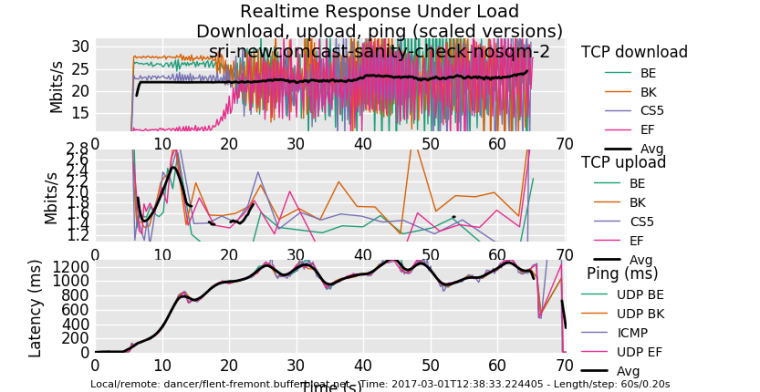
0_1539192524603_rrul_be-2017-03-01T123958.188746.sri_newcomcast_sanity_check_nosqm_2.flent.gz
See how long the red download flow takes to get to parity? 20 seconds. Thats because it started just slightly late, and could not catch up with the other flows. This is what happens to any new flow (like, um, dns or tcp or...) when you have a flow already eating the link and your RTT climbs to 1 sec....
The upload flows are almost completely starved (1sec RTT!).
-
using the squarewave test is fun too. Not doin that... But anyway, for comparison, I get about twice the upload performance and 15ms added latency on this hardware (an arm neon) running cake... and I'm running low on cpu here. (There's also other real traffic). Same cablemodem....
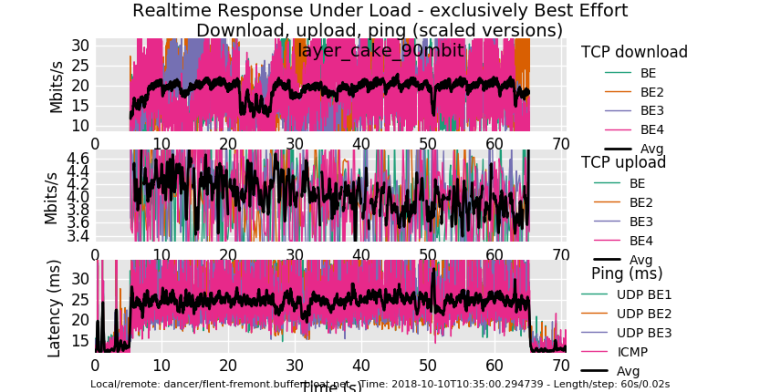
After i get off this call I'll kill the download shaper and see what happens... but I'm in a call while I was doing this and nobody noticed... :)!0_1539193422893_rrul_be-2018-10-10T103500.294739.layer_cake_90mbit.flent.gz
-
ok, glutton for punishment. Shaped up only. I sure hope the rest of the world isn't as miserably overbuffered as comcast's CMTSes are.....
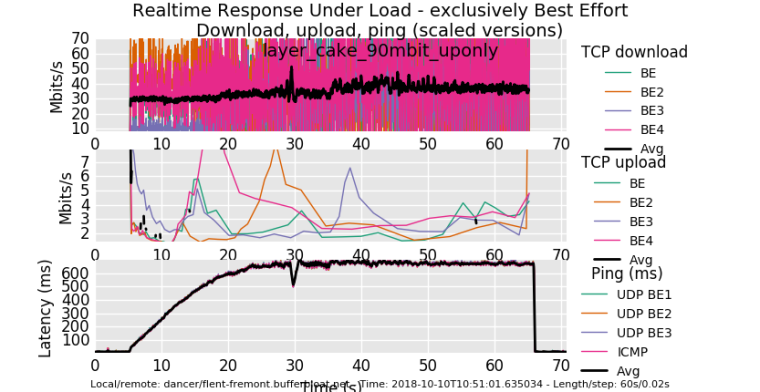
0_1539194140099_rrul_be-2018-10-10T105101.635034.layer_cake_90mbit_uponly.flent.gz
I campaigned hard to get the cable industry to cut their CMTS buffering to a 100ms TOPs. So we're still suffering. pie on the modem is not enough. cheap arm and x86 hardware is not enough....
-
@tibere86 look at the link tman posted, they did try 1024,2048,4096 as values.
-
@zwck Thanks. I see it now.
-
@dtaht thanks for filing the icmp + limiter + NAT bug #9024. I added my note addressing the comment on the filter rules.
I also did some testing with OPNsense 18.7.4 where the aforementioned bug is not present. I've noticed that both with and without NAT, latency is lower across OPNsense with regard to limiters + codel + fq_codel at 800mbit in my tests using the lab. (Codel, and fq_codel settings were same for both distros) Trying to track down what's different between the distros that may address this.
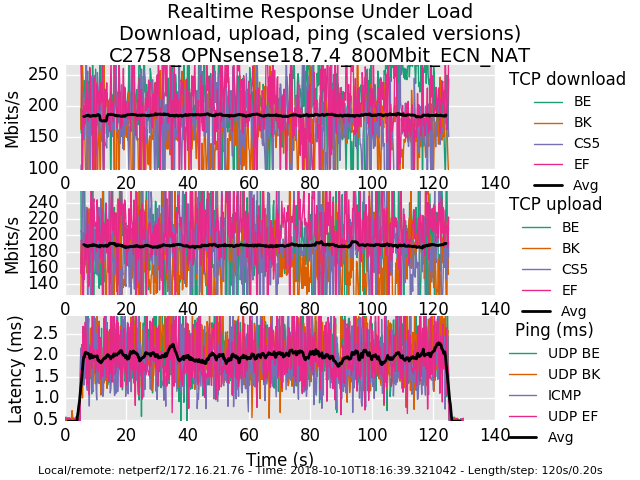
0_1539221734101_rrul-2018-10-10T181639.321042.C2758_OPNsense18_7_4_800Mbit_ECN_NAT.flent.gz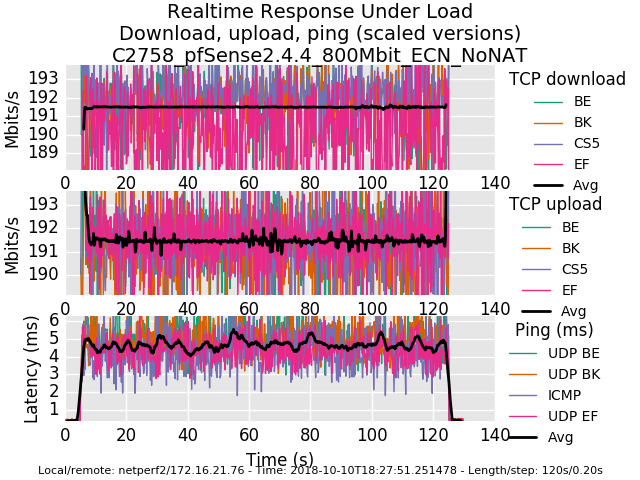
0_1539221755472_rrul-2018-10-10T182751.251478.C2758_pfSense2_4_4_800Mbit_ECN_NoNAT.flent.gzAnd for posterity, here is a comparison of a Frontier FIOS connection without and with fq_codel shaping today.
-
I distinctly remember my graphs being flatter before the 2.4.4 update.
edit: re-uploading the pic results in an "error"
0_1539252489446_rrul-2018-10-11T115959.048554.300_100-with-masks.flent.gz
I am testing against my own vps server. Limiters are applied on the LAN interface as interface rules.
-
Here is one with rules applied on the WAN via a floating rule.
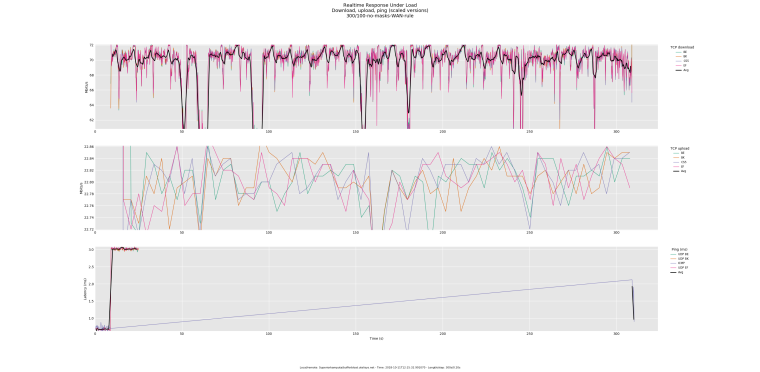
0_1539253359216_rrul-2018-10-11T121532.991070.300_100-no-masks-WAN-rule.flent.gz
FYI, the above results are on 1G symmetrical link. The test server is also on a 1G symmetrical link. The LAN is NAT-ted on a CARP address.
-
My results are really bad. It could be that my modem is listed on that bad modem website

I tweaked some settings but keep getting bad results.
ipfw sched show 00001: 181.000 Mbit/s 0 ms burst 0 q65537 50 sl. 0 flows (1 buckets) sched 1 weight 0 lmax 0 pri 0 droptail sched 1 type FQ_CODEL flags 0x0 0 buckets 0 active FQ_CODEL target 8ms interval 80ms quantum 1518 limit 10240 flows 1024 NoECN Children flowsets: 1 00002: 16.000 Mbit/s 0 ms burst 0 q65538 50 sl. 0 flows (1 buckets) sched 2 weight 0 lmax 0 pri 0 droptail sched 2 type FQ_CODEL flags 0x0 0 buckets 0 active FQ_CODEL target 8ms interval 80ms quantum 1518 limit 10240 flows 1024 NoECN Children flowsets: 2 -
@strangegopher Your induced latency is poor. Your up graph looks fairly normal, your down graph is not quite matching what you set it to. (cpu?). There's evidence of pre-2002 levels of dscp prioritization (somewhere) in that BK (CS1) is treated better than BE (CS1), CS5 is also prioritized, and EF is deprioritized. (try a rrul_be test on the same modem, though)
This bit of magic keeps my badmodem.com modem "more alive", at a cost of some bandwidth:
hping3 -2 -d 0 -s 10080 -k -p 80 -i u150 IP-OF-FIRST-OUTSIDE-CABLE-HOP-HERE
courtesy the relevant thread on the cake mailing list: https://lists.bufferbloat.net/pipermail/cake/2018-July/004128.html
-
First of all thank you dtaht & the bufferbloat team for an absolutly outstanding toolset. I used HFSC/fq_codel on PFSense before, and the results were good. Then I read about CAKE, so I slammed together an AMD Kabini mini-itx box I had flying about, put ubuntu server and CAKE on it, and deployed that between my PFSense gateway and my Negear CM600 modem. I switched off shaping/limiters on the PFSense gateway, all shaping is handled by the new box using cake.
Below are the results, first pic is without shaping, second one with shaping.
Cheers,
Christian.


-
@xciter327 yea, that's miserable. You lost all the udp packets under load, too. But is it the floating rule or something else? What speed hardware? Whose 1G link? What's the next device in the chain up? Can you temporarily drop carp out of the equation?
I would just like to depressedly note that these sort of problems are seemingly universal across home and business links today - not just the bufferbloat - it's amazing the internet works at all, sometimes.
-
@dtaht said in Playing with fq_codel in 2.4:
@xciter327 yea, that's miserable. You lost all the udp packets under load, too. But is it the floating rule or something else? What speed hardware? Whose 1G link? What's the next device in the chain up? Can you temporarily drop carp out of the equation?
I would just like to depressedly note that these sort of problems are seemingly universal across home and business links today - not just the bufferbloat - it's amazing the internet works at all, sometimes.
I deeply share You sentiment about the Internet working at all. To answer some questions:
- I don't know if it's the floating rule or not, that's why I am testing :)
- Hardware is Atom C2758 with Intel NICs with all the offloading capabilities disabled.
- My 1Gbps link. I work for an ISP. Can control pretty much anything in the chain.
- I can rule out CARP as a culprit. Will test this in a closed environment.
P.S. - for some reason I keep getting an error messages when I try to add a screenshot to a post.
